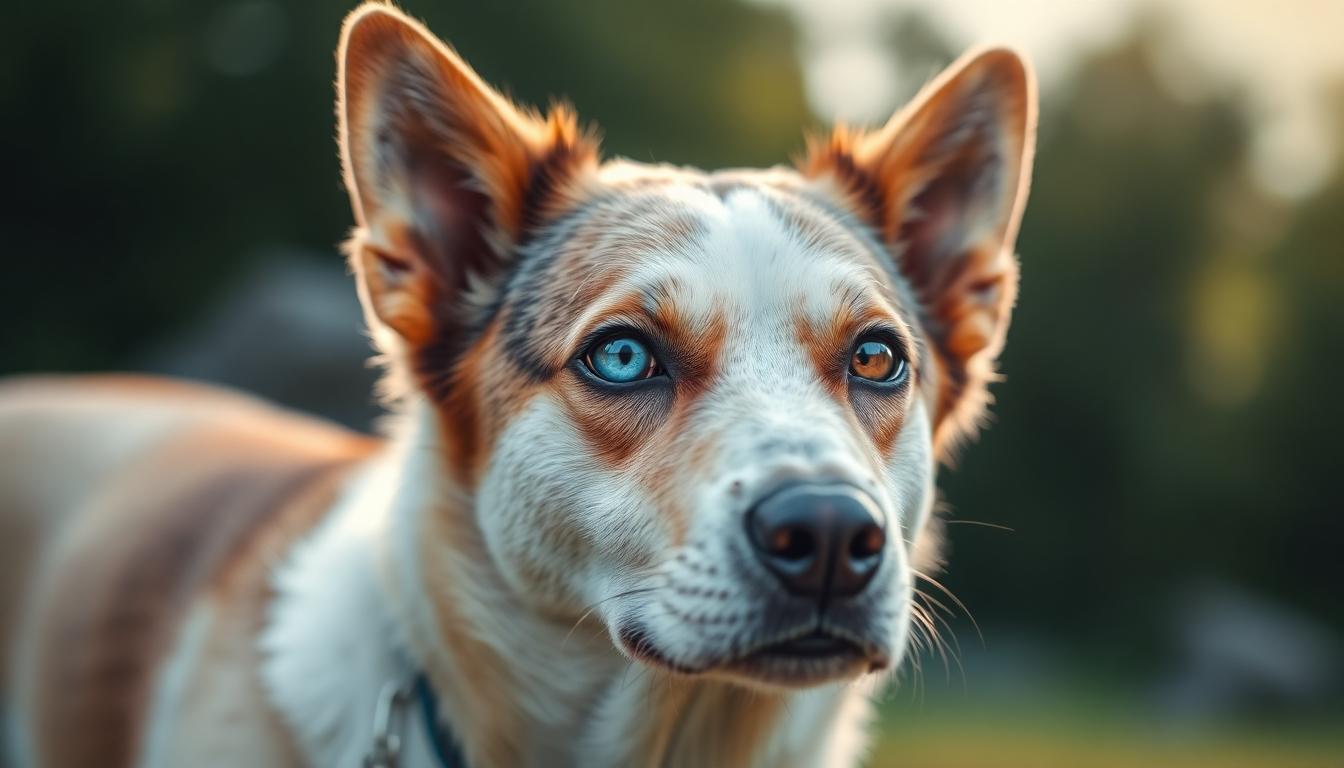Have you ever gazed into the mesmerizing eyes of a dog with two different colors? These unique canines, known for their heterochromia, aren’t just visually striking—they’re believed to carry profound spiritual significance across cultures worldwide.
We’ve discovered that these special dogs are often considered spiritual bridges between worlds. From ancient folklore to modern spiritual practices, dogs with one blue eye and one brown (or other combination) are thought to possess extraordinary abilities, including heightened intuition, protective energies, and even connections to the supernatural area. Many spiritual practitioners believe these rare companions serve as powerful spirit guides.
The Mystical Phenomenon of Heterochromia in Dogs
Heterochromia represents a captivating genetic anomaly where dogs possess irises of different colors. This remarkable condition occurs when the distribution of melanin varies between the eyes, creating a striking visual contrast. Many dog owners first notice this unique feature when their puppies open their eyes, typically around 10-14 days after birth.
Several dog breeds commonly display heterochromia, including Siberian Huskies, Australian Shepherds, Border Collies, and Dalmatians. The contrast can range from subtle variations in shade to dramatically different colors like ice blue paired with deep brown. Complete heterochromia affects the entire iris of each eye, while sectoral heterochromia creates partial color differences within a single iris.
From a biological perspective, heterochromia typically doesn’t impact a dog’s vision or health. Veterinarians categorize this condition as either congenital (present from birth) or acquired (developing later due to injury or disease). Congenital heterochromia stems from genetic inheritance patterns that influence melanin production during embryonic development.
Ancient cultures viewed these distinctive-eyed canines with particular reverence, believing their mismatched eyes symbolized an ability to see both physical and spiritual realms simultaneously. This perspective has carried forward into modern spiritual interpretations, where heterochromatic dogs are often considered natural mediums between worlds.
Many spiritual practitioners believe these dogs possess heightened sensitivity to supernatural energies and can detect entities invisible to humans and other animals. Their unique appearance reinforces the perception that they’re specially marked by divine forces for a greater purpose. This connection to both visible and invisible dimensions makes them particularly valuable companions for individuals on spiritual journeys seeking guidance beyond ordinary perception.
What Is Heterochromia in Dogs?

Heterochromia in dogs refers to the captivating phenomenon where a canine has two differently colored eyes. This distinctive trait isn’t just a biological curiosity but carries profound spiritual meanings across various cultural traditions.
Natural Causes vs. Genetic Factors
Heterochromia primarily stems from genetic factors that affect melanin distribution in the iris. The amount and distribution of this pigment determines eye color, creating either complete heterochromia (two entirely different colored eyes) or sectoral heterochromia (partial color differences within one iris). Genetic mutations affecting melanin production can occur naturally during embryonic development, leading to this unique trait that’s particularly common in breeds like Siberian Huskies, Australian Shepherds, Border Collies, and Dalmatians. Some cases of heterochromia may develop later in a dog’s life due to injuries or conditions affecting the eye, though congenital heterochromia is more frequently observed. Most importantly, this condition rarely impacts a dog’s vision or overall health, making it primarily an aesthetic characteristic with deep spiritual significance rather than a medical concern.
Historical Significance of Differently Colored Eyes

The historical significance of dogs with heterochromia spans across many ancient civilizations, each attributing unique mystical qualities to these distinctive animals. Tibetan Buddhism recognizes heterochromatic dogs as potential enlightened beings, symbolizing the perfect harmony between opposing forces and spiritual balance. Native American traditions held these special canines in high regard, believing they possessed the extraordinary ability to simultaneously observe both earthly and heavenly realms, making them exceptional spiritual guides bridging our industry and the afterlife.
Ancient Egyptians connected heterochromatic dogs with Anubis, the powerful deity who guided souls through the afterlife. These special companions were thought to travel between the mortal area and the hereafter, serving as guardians and guides for departed souls. Folklore from diverse cultures consistently portrays dogs with differently colored eyes as mystical creatures embodying profound balance, representing the harmonious coexistence of seemingly contradictory elements in nature.
The widespread reverence for heterochromatic dogs throughout history highlights humanity’s enduring fascination with these unique animals. Their distinctive appearance transcended mere aesthetics in ancient societies, instead becoming powerful symbols of spiritual insight and cosmic balance. Many historical texts and artifacts depict these special canines as divine messengers capable of perceiving both visible and invisible dimensions, a belief that continues to influence spiritual interpretations of heterochromia in dogs today.
Spiritual Meanings Behind Dogs With Two Different Colored Eyes

Dogs with heterochromia (two different colored eyes) carry profound spiritual meanings across various cultures and traditions. This unique physical trait transcends mere biological curiosity, embodying deeper symbolic significance that has fascinated spiritual practitioners for centuries.
Symbol of Balance Between Worlds
Heterochromatic dogs represent the harmonious balance between different realms and perspectives. Their distinctive eyes symbolize the coexistence of seemingly contradictory elements in perfect equilibrium. Many spiritual traditions interpret this duality as a physical manifestation of yin and yang energies, with each eye representing a different aspect of existence. These special canines teach us to embrace diversity and recognize the profound harmony in differences. Their very appearance serves as a reminder that apparent opposites can exist together in a single being, reflecting the universal truth that balance exists throughout nature.
Guardian of Spiritual Realms
Ancient cultures, particularly Egyptian and Native American traditions, revered dogs with heterochromia as sacred guardians of spiritual boundaries. These unique canines were believed to possess the ability to see into both the physical industry and spiritual realms simultaneously. Egyptian mythology connected heterochromatic dogs with afterlife deities, considering them companions who could guide departed souls safely to the next industry. Native American folklore similarly viewed these dogs as protectors stationed between realms, capable of detecting spiritual threats invisible to humans. Their dual-colored gaze was considered evidence of their ability to perceive multiple dimensions, making them invaluable spiritual allies.
Enhanced Intuition and Perception
Heterochromia in dogs is commonly associated with heightened spiritual awareness and exceptional intuitive capabilities. Their different colored eyes are thought to grant them enhanced perception beyond ordinary sensory abilities. Spiritual practitioners often note that these dogs display unusual sensitivities to energies, emotions, and spiritual presences in their environment. Their capacity for perceiving what humans cannot makes them particularly valued companions for those on spiritual journeys. Many owners of heterochromatic dogs report their pets demonstrating remarkable behaviors that suggest awareness of unseen presences, further reinforcing their reputation as beings with extraordinary spiritual sight and divine connections.
Cultural Interpretations Across Different Societies

Dogs with heterochromia have captivated human imagination across many cultures and spiritual traditions. These unique canines with dual-colored eyes are interpreted differently throughout various societies, yet common themes of spiritual significance emerge consistently.
Native American Perspectives
Native Americans regard dogs with mismatched eyes as powerful spiritual guides with extraordinary perceptive abilities. In these traditions, the contrasting eye colors represent a dog’s capacity to simultaneously view both earthly and divine realms. One eye (typically blue) symbolizes the heavenly dimension, while the other (usually brown) represents the earthly plane, allowing these special companions to serve as bridges between physical and spiritual worlds. Native peoples honor these dogs as spiritual protectors and invaluable intermediaries that help humans navigate life’s complex journeys with greater awareness and insight.
Eastern Philosophical Views
Tibetan Buddhism embraces heterochromatic dogs as living symbols of harmony and balanced life forces. Their unique appearance reflects the perfect coexistence of dual energies within a single being, embodying the core Buddhist principle of equilibrium. These dogs are sometimes associated with enlightened beings who possess profound spiritual wisdom. Ancient Egyptian culture connected dogs with differently colored eyes to Anubis, their revered god of the afterlife. Egyptians believed these special canines served as divine companions tasked with guiding souls through their transition beyond the physical area, cementing their status as spiritually important creatures.
Common cross-cultural themes emerge when examining heterochromatic dogs in spiritual contexts. They universally symbolize duality and balance between opposing forces such as life and death or physical and spiritual realms. Cultures worldwide associate these dogs with heightened intuition and supernatural perception, believing they possess a unique form of spiritual sight. Also, many traditions revere them as guardians of spiritual domains or guides for those who have passed on, highlighting humanity’s enduring fascination with these distinctively-eyed companions.
How to Connect With Your Heterochromatic Dog’s Spiritual Energy

Connecting with your heterochromatic dog’s spiritual energy creates a deeper bond between you and your unique companion. The journey begins with mindful observation of your dog’s nature and behaviors, paying special attention to how they interact with their environment. Dogs with two different colored eyes have been revered across multiple spiritual traditions for their ability to bridge physical and spiritual realms.
Observe Its Nature
Recognizing your dog’s unique qualities helps establish a spiritual connection that honors their distinctive energy. Take time each day to observe how your heterochromatic companion responds to different situations and environments. Their behaviors might reveal spiritual sensitivities that dogs with matching eyes don’t typically display. Native American traditions particularly emphasize this observation practice, believing these dogs can see both earthly and heavenly realms simultaneously.
Embrace Diversity
Appreciating the symbolic representation of balance and harmony in your dog’s mismatched eyes opens doorways to spiritual understanding. Their heterochromia physically manifests the integration of opposites that many spiritual practices seek to achieve. Tibetan Buddhist traditions view this visual duality as an embodiment of enlightened qualities, highlighting life’s complexity and balance. By meditating on this natural harmony, you’ll develop greater appreciation for your dog’s spiritual significance.
Cultivate Empathy
Developing a deeper understanding of your heterochromatic dog happens through empathetic interaction that acknowledges their spiritual nature. Communicate with your dog through gentle touch, maintaining eye contact with both their differently colored eyes to honor their dual perspective. This practice strengthens your intuitive bond and enables you to become more receptive to the spiritual messages your dog might convey.
Spiritual Practices
Captivating in spiritual rituals alongside your heterochromatic companion enhances both your spiritual journeys. Create a quiet space where you can meditate with your dog nearby, allowing their balanced energy to influence your practice. Ancient Egyptian traditions associated these dogs with Anubis, the god of the afterlife, suggesting their ability to guide souls between worlds. Incorporate elements that honor this guiding energy, such as walking meditation with your dog or creating sacred space that accommodates both of you.
Modern Spiritual Significance for Dog Owners

Owners of heterochromatic dogs often experience a profound sense of spiritual connection with their companions. These dogs symbolize the harmonious coexistence of opposing forces, reflecting the beautiful balance between light and dark, physical and spiritual realms. Their unique appearance serves as a daily reminder to embrace diversity and seek deeper spiritual awareness in our lives.
Many dog owners report their heterochromatic companions display heightened intuition during life transitions. These special dogs act as intuitive protectors, seemingly aware of their owners’ emotional states and providing comfort during challenging times. Their dual-colored gaze is believed to represent an enhanced ability to perceive both physical and spiritual energies, making them particularly sensitive to changes in their environment.
Heterochromatic dogs function as living talismans in many traditions, attracting positive energy and good fortune to their homes. Their distinctive eyes represent a manifestation of inner spiritual complexity that goes beyond their physical appearance. This unique trait fosters a sense of connection to mystical or ancestral realms for many owners, deepening the bond between human and canine companion.
The perception of these dogs extends beyond mere companionship into the area of spiritual guidance. Their striking appearance frequently reminds owners to look beyond surface differences and appreciate the deeper connection between all living beings. This perspective transforms the relationship from simple pet ownership to a meaningful spiritual partnership that enriches both lives.
Conclusion
Dogs with heterochromia invite us to look beyond the physical industry and embrace deeper spiritual connections. Their distinctive gaze serves as a powerful reminder that balance beauty and meaning often coexist in unexpected places.
We’ve seen how these remarkable companions transcend ordinary pet relationships to become spiritual guides with roots in diverse cultural traditions. Their dual-colored eyes continue to fascinate us not just for their striking appearance but for the profound symbolism they carry.
Whether you believe in their mystical abilities or simply appreciate their unique beauty remember that these special dogs offer us a glimpse into the delicate harmony between different realms. By honoring their spiritual significance we open ourselves to the deeper wisdom these extraordinary animals bring into our lives.
Frequently Asked Questions
What is heterochromia in dogs?
Heterochromia is a genetic condition where dogs have two different colored eyes. It results from varying melanin distribution in the irises and can appear as complete heterochromia (entirely different colored eyes) or sectoral heterochromia (partial color differences within one iris). This distinctive trait is most common in breeds like Siberian Huskies, Australian Shepherds, Border Collies, and Dalmatians.
Does heterochromia affect a dog’s vision or health?
No, heterochromia typically doesn’t affect a dog’s vision or overall health. It’s primarily an aesthetic condition caused by melanin distribution in the iris. While most cases are congenital (present from birth), some may develop later due to injuries or other conditions. Regular veterinary check-ups are still recommended as with any dog, but the different colored eyes themselves aren’t usually a health concern.
When do puppies develop heterochromia?
Puppy owners can notice heterochromia when their puppies open their eyes, typically around 10-14 days after birth. The distinctive eye coloration becomes apparent during this early developmental stage. However, a puppy’s eye color can continue to change during the first few months of life, so the final appearance of heterochromia may not be fully established until the puppy is older.
What spiritual significance do heterochromatic dogs have?
Across cultures, heterochromatic dogs are viewed as spiritual bridges with extraordinary abilities. They’re believed to possess heightened intuition and protective energies, capable of seeing both physical and spiritual realms. Ancient traditions and modern spiritual practices consider them powerful spirit guides, symbols of balance between opposing forces, and guardians with enhanced perception of supernatural energies not visible to humans.
Which dog breeds commonly have heterochromia?
Siberian Huskies, Australian Shepherds, Border Collies, and Dalmatians most commonly exhibit heterochromia. Other breeds where this trait appears include Catahoula Leopard Dogs, Great Danes, Dachshunds, Shih Tzus, and some mixed breeds. The genetic factors responsible for heterochromia are more prevalent in these breeds, making the distinctive two-colored eye pattern more frequently observed in these canines.
How did ancient cultures view dogs with heterochromia?
Ancient cultures revered heterochromatic dogs as sacred beings. Tibetan Buddhism viewed them as enlightened beings symbolizing harmony between opposing forces. Native Americans considered them exceptional spiritual guides observing both earthly and heavenly realms. In ancient Egypt, they were associated with Anubis, guiding souls through the afterlife. This widespread reverence shows humanity’s enduring fascination with these unique animals as symbols of spiritual insight.
How can owners connect with their heterochromatic dog’s spiritual energy?
Owners can connect with their heterochromatic dog’s spiritual energy through mindful observation of their behaviors, embracing the symbolism of balance in their mismatched eyes, and engaging in empathetic interaction through eye contact and gentle touch. Creating sacred spaces and including the dog in meditation practices can further strengthen this spiritual bond, honoring the dog’s unique energy and fostering a deeper connection.
Is heterochromia in dogs rare?
While not extremely rare, heterochromia is certainly uncommon enough to make these dogs stand out. It appears more frequently in specific breeds like Siberian Huskies and Australian Shepherds due to genetic factors. Complete heterochromia (two entirely different colored eyes) is less common than sectoral heterochromia (partial color differences within one iris). This distinctive trait continues to fascinate dog lovers and spiritual enthusiasts alike.







